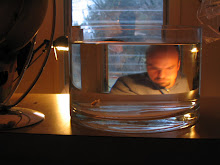 Near the end of his piece on the musician Trent Reznor in this week's New Yorker, Sasha Frere-Jones quotes the Nine Inch Nails mastermind on the current state of popular sound technology. “Walk into a Best Buy," says Reznor, "and everyone’s obsessed with the highest possible resolution for their TVs. 1080p versus 1080i resolution, hundred-dollar HDMI video cables . . . yet everyone still walks around with those terrible quality white iPod ‘earbuds.’ ”
Near the end of his piece on the musician Trent Reznor in this week's New Yorker, Sasha Frere-Jones quotes the Nine Inch Nails mastermind on the current state of popular sound technology. “Walk into a Best Buy," says Reznor, "and everyone’s obsessed with the highest possible resolution for their TVs. 1080p versus 1080i resolution, hundred-dollar HDMI video cables . . . yet everyone still walks around with those terrible quality white iPod ‘earbuds.’ ”An interesting point. Granted, his analogy's not quite fair. (After all, we don't walk around with our TVs, but rather often make do, while on the subway, with similarly terrible images on a cellphone screen, or without digital imagery at all.) Still, Reznor's right that consumers often put up with a quality of reproduced sound that is pretty feeble. For a musician who is concerned, as he is, with layering and with the precise qualities of sounds, the thin tones that emerge from earphones are hardly music at all. Listening to them, rather, is something like eating cardboard.
So today's post is dedicated to the idea of experiencing things fully, with all of the senses. While you're driving today, pop a CD into the car stereo, if you've got one, and really let her rip. Pause a moment, during breakfast, to really taste the bread that you've buttered. Or eat a coffee bean. Stare at the cracked course of ants in the sidewalk; wander through the perfumes section of the department store, and try several samples.
And I'll do the same, in the meantime, with Cleo. Most baby books suggest introducing the infant to a range of textures, and smells. Tastes come later, of course, but simply rubbing a baby's hand against silk, and then bark, or touching her feet with a feather, can spur both interest and brain development. So, too, with sounds: a diet of varied noises - barks, breezes, burbling brooks - can prompt curiosity, and a nascent awareness of the world's complexity. So on our walk today I'll press her little feet against the base of an oak tree, and we'll brush our hands against leaves.
That's standard advice, as I said, to parents of babies. But I like the variation on the same theme that was offered by the 12-year-old daughter of a friend who was over for dinner a couple of nights ago. Each year, it turns out, a number of students in her school go on a trip to Costa Rica. She hopes, reasonably, to go this year. And what do you do there? I asked. Well, she said, you walk through forests, and you go to museums. But there is also a marine center, and you have to kiss one of the animals. My friend, she said, kissed a squid.
A squid! My word.
Oh, it wasn't that bad, added our friend's daughter. Other people had to kiss the starfish.




My brother-in-law works for a company that makes high-end digital stereo systems, using "lossless" file formats. The 128kbps mp3s drive him nuts, but he makes an interesting point about it all: consumers, he says, will always trade convenience for quality. Records were more convenient than live performances, tapes were more convenient than records, CDs represented an uptick in quality, but for a while tapes remained more convenient (Discmans and car CD players remained expensive and prone to skip) and were used just as much. MP3's, of course, represent a huge leap in convenience, and loss in quality. The earbuds, even, represent this tendency as they are more convenient than bulky, high-quality padded headphones.
ReplyDeleteIt's a fascinating idea to play around with in other areas. Look at food - you can see the same trend there, although with more dire results.